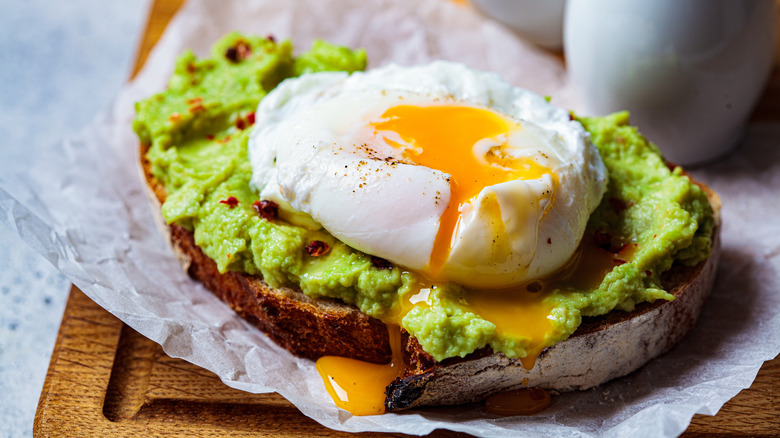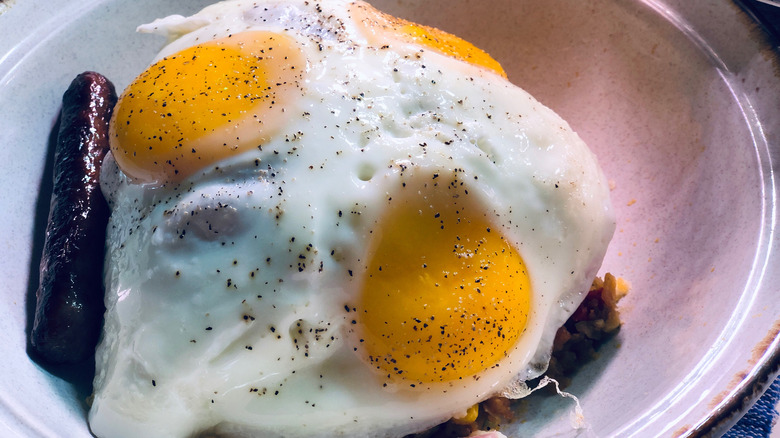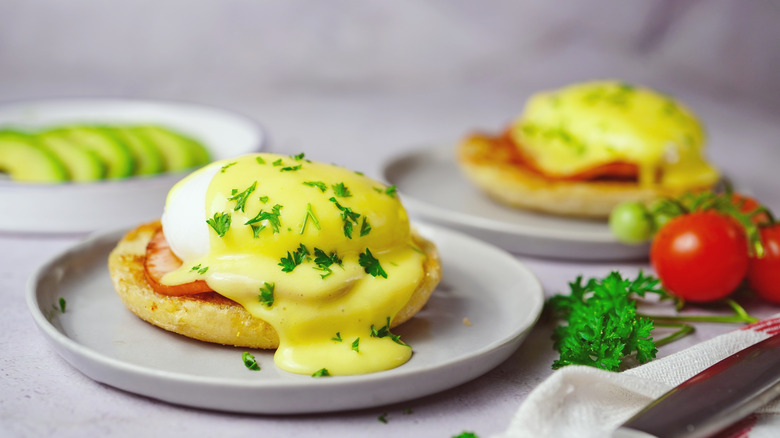What's The Difference Between A Basted Egg And A Poached Egg?
How do you like your eggs? It's nice having options, isn't it? Eggs are one of those versatile foods; you cook them in many different ways and use them in hundreds of different recipes. According to Bob Evans, some of the most popular ways to cook an egg include scrambled, boiled, omelet-style, and over-easy, but two methods that aren't on their list are basted and poached.
If you're not a huge brunch fan, it's possible you haven't even heard of one or both of these methods — or perhaps you have and just don't know the difference. Although neither can be called the most common way to cook an egg, both still deserve some attention. Plus, if you've never had either one, you might feel inspired to poach one egg and baste another just to see which one you like best. You know ... like Julia Roberts did in the 1999 rom-com "Runaway Bride."
Both eggs are prepared using water, and both look similar after being cooked, so what's the difference between a basted egg and a poached egg? It all comes down to a few little cooking nuances.
How to cook a basted egg
Organic Authority claims basted eggs aren't common in the United States, and it's not a method you can request at every restaurant, unlike scrambled and sunny-side-up. Basting a food means moistening it with a liquid (or better yet, a fat) to add or improve taste and prevent dehydration, says the USDA. More specifically, the moistening occurs with the food's natural juice or sauce, or an added condiment like butter, Wide Open Eats explains.
The basting technique is typically associated with poultry like turkey or chicken, but you can also baste an egg. One way to do it, detailed by The Cookful, involves cracking an egg into a hot butter-coated skillet, waiting until the whites are stable, then pouring hot water over the skillet and covering it. The steam created from the water trapped under the lid helps to cook the egg while the butter helps to flavor it.
When the whites are completely set and the membrane covering the yolk is white, the egg is basted and ready to eat. Simply use a spatula to gently move it from the skillet to your plate. When you cut into the yolk, it should be thin and runny, as shown in ForkNPlate's tutorial.
How to cook a poached egg
Poached eggs are the kind used in eggs Benedict, which, by the way, ended up being Julia Roberts' favorite in "Runaway Bride." MasterClass described the "poached" cooking technique as one that involves a "gently simmering liquid."
Chef Adrienne Cheatham shared her fool-proof way to cook poached eggs with Epicurious on YouTube. She begins by mixing vinegar and water into a bowl (other recipes use only water, but the vinegar helps the proteins on the egg's surface hold the signature "teardrop shape"). She then cracks the eggs directly into the bowl and lets them soak for about 10 minutes. You'll know the eggs are ready for poaching when the white portion turns an opaque color.
Next, she scoops the eggs (one by one) and a portion of the vinegar solution into a simmering pot of water. As with basted eggs, once the egg whites are set, they're ready to remove. When you cut into the eggs, the yolks should be deliciously runny, but with a slightly thicker consistency than that of basted eggs.
To recap, a basted egg is cooked using hot butter or oil, plus water poured over the egg. A poached egg is cooked using a water and vinegar solution followed by simmering water — or just simmering water by itself. Both methods result in a soft exterior and runny yolk, but because of the inclusion of butter or oil, some would argue that the less common basted eggs actually offer a better flavor, while the vinegar involved in poaching an egg might result in a more Instagram-worthy final product.


